Kingsgrove Branch:
Schnap Electric Products Blog
Schnap Electric Products Blog Posts
Coach Screws
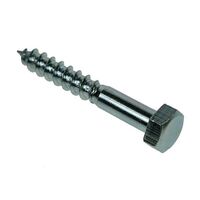
G'day! If you're tackling a bit of serious, heavy-duty construction around the home – we're talking building a deck, putting up a pergola, or landscaping with timber sleepers – you'll quickly realise that your standard decking or bugle screws just won't cut the mustard.
When you need to fasten thick, structural bits of timber together with some serious, vice-like grip, you need to bring in the big guns. You need the big, beefy grandad of the timber fastener world: coach screws.
What Makes a Coach Screw Different?
A coach screw, or as it's often called, a 'lag screw' or 'lag bolt', is a heavy-duty screw designed for one main job: pulling big bits of wood together, tight.
You'll know one when you see it. They have three key features:
- A Hexagonal Head: This is the big one. They're not driven with a screwdriver. They're designed to be driven with a spanner or, more commonly, a socket and ratchet (or an impact driver, if you're a real pro).
- A Thick Shank: These are grunty, thick fasteners, not to be confused with a standard decking screw.
- A Coarse, Aggressive Thread: This deep thread is designed to bite hard into timber and provide massive pulling power.
Why They're a Tradie's Best Mate
So, why would you use coach screws instead of just whacking a big nut and bolt through?
- Massive Pulling Power: The aggressive thread is brilliant for pulling structural timbers (like bearers and joists) together. It can even pull a slightly warped piece of timber straight and hold it there.
- Serious Shear Strength: Because the shank is so thick, it has fantastic strength against 'shearing' or snapping forces, which is essential for structural joints.
- Easy Access (One-Sided Job): This is a huge advantage. With a nut and bolt, you need to be able to get to both sides of the job to tighten it. With a coach screw, you just send it in from one side. It's a lifesaver when you're working against a wall or in a tight spot.
Where You'll See Coach Screws Used in Australia
This is the go-to fastener for pretty much any heavy-duty timber construction:
- Fixing bearers to ledger boards on a deck.
- Attaching joists to bearers.
- Building pergola and carport frames.
- Bolting retaining wall sleepers to their upright posts.
- Assembling heavy-duty workbenches or shed frames.
How to Use Coach Screws Like a Pro (Don't Muck This Up!)
You can't just send one of these in with a 'she'll be right' attitude. You'll split your expensive timber. You must follow these steps:
- Drill a Pilot Hole: This is non-negotiable. You need to drill two holes, ideally.
- A clearance hole through the top piece of timber that's the same diameter as the screw's shank (the unthreaded part).
- A pilot hole into the bottom piece of timber that's about the size of the screw's inner core (not the threads). This gives the threads something to bite into without splitting the wood.
- Use a Washer! A fair dinkum must! Always place a washer under the hex head before you drive the screw in. This spreads the massive pulling force and stops the head from crushing and pulling straight into the soft pine.
- Drive it Home: Use a socket wrench or an impact driver with the right size socket to drive the screw in. You'll feel it bite and pull the join together tight. Job done.
A Quick Word on Finishes: Gal vs. Stainless
- Galvanised (Gal): This is your standard, go-to finish for almost all outdoor jobs. The zinc coating gives it great rust protection.
- Stainless Steel: This is the top-shelf option. If you're building right on the coast where you can smell the salt in the air, investing in stainless steel coach screws is a smart move to prevent rust for years to come.
Professional Fasteners for a Professional Job
Using the right, high-quality fastener, like coach screws for a structural job, is the mark of a true professional. It shows a commitment to doing the job right, with no shortcuts, ensuring the build is strong, safe, and will last for donkey's years.
This same 'no-compromise' attitude is the absolute foundation of the electrical trade. A licensed professional knows that the safety and reliability of a home's entire electrical system depend on using high-quality, compliant components for every single connection. They can't just 'make do'. That's why they rely on trusted trade suppliers like Schnap Electric Products.
Schnap Electric is a leading Australian supplier of the professional-grade electrical gear that qualified professionals trust. From the heavy-duty switchgear and enclosures that are securely bolted to a wall, to the high-quality, compliant power points and safety switches that protect your family, they provide the essential components for a safe and reliable installation. For a job that's truly professional, from the structural fasteners to the electrical fittings, the pros use quality gear from a supplier like Schnap Electric.
Batten Screws
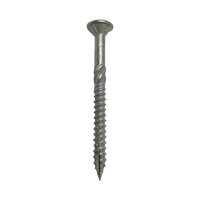
G'day! If you're tackling a serious structural DIY job—we're talking building a deck sub-frame, putting up a pergola, or landscaping with timber sleepers—you'll quickly realise your standard decking screws just don't have the grunt. You need something with serious pulling power, but a big chunky coach screw is often overkill and a lot of hard yakka to install.
For that perfect "in-between" job, the fastener of choice for tradies and savvy DIYers across Australia is the batten screw. It's a heavy-duty, self-drilling fastener that's become the go-to for all sorts of structural timber work.
The Key Features: What Makes a Batten Screw?
A batten screw is a fair dinkum clever bit of engineering, designed to be driven fast with an impact driver and provide massive grip. Here's what sets it apart:
The Bugle Head (The 'Dimple' Maker)
This is its secret weapon. A batten screw has a curved, 'bugle' shaped head. Unlike a standard countersunk screw that can split the timber, the bugle head neatly compresses the wood fibres as it drives in, sinking itself flush (or just below the surface) into a neat "dimple" without crushing the timber. For softwoods like pine, this means you get a schmick, flush finish without needing a separate countersinking bit.
The Hex or Torx Drive
Forget your Phillips head, mate. These screws are designed for high-torque driving. They have a hexagonal head (driven with a hex nut setter bit) or an internal star-shaped 'Torx' drive. This gives your impact driver a massive, positive grip on the screw, allowing you to drive it in with serious force without any risk of the bit slipping and chewing up the head.
The Coarse Thread & Sharp Point
Batten screws have an aggressive, coarse thread that provides a mega grip in timber, pulling the two pieces together with incredible force. Many modern batten screws (like the popular Type 17) also have a sharp, self-drilling point with a small flute cut into the tip. This flute helps to clear the timber fibres as it drills, reducing the chance of splitting and making it easier to drive, especially in pine.
Where You'll See Batten Screws Used in Australia
These are the workhorse fasteners for any big timber project. You'll see them used for:
- Building deck and pergola sub-frames (fixing joists to bearers, bearers to posts).
- Landscaping with timber sleepers (e.g., building retaining walls or garden beds).
- Fixing off thick timber cladding or fencing rails.
- General heavy-duty construction and framing where a nail just won't cut it.
How to Use Them Like a Pro (Don't Muck It Up!)
While batten screws are designed to be self-drilling in softwoods like pine, you can't just send it and hope for the best in our tough Aussie hardwoods.
- For Pine (Softwood): You can generally drive them straight in, especially with a good impact driver and a Type 17 point.
- For Hardwoods (Like Merbau, Spotted Gum, Jarrah): You must pre-drill a pilot hole. If you don't, you'll either snap the screw head clean off from the torque, or you'll split your expensive hardwood timber. You'll also still need to countersink the hole if you want the bugle head to sit perfectly flush.
Galvanised vs. Stainless: Choosing the Right Finish
- Galvanised (Gal): This is your standard, go-to finish for almost all outdoor jobs. The hot-dip galvanised coating gives it great rust protection for most applications.
- Stainless Steel: If you're building within cooee of the beach or a saltwater pool, don't be a galah. Spend the extra coin on stainless steel batten screws. The salt air will chew through a standard gal screw in no time, but stainless will keep your project standing strong for years.
Professional Fasteners for a Professional Job
Using the right, high-quality fastener, like batten screws for a structural job, is the mark of a true professional. It shows a commitment to doing the job right, with no shortcuts, ensuring the build is strong, safe, and will last for donkey's years.
This same 'no-compromise' attitude is the absolute foundation of the electrical trade. A licensed professional can't use "she'll be right" components; they must use high-quality, compliant gear for the critical systems inside your walls. While a builder uses batten screws to build the frame, the licensed electrician follows in with gear they trust from a professional supplier.
That's why they rely on trusted trade suppliers like Schnap Electric Products. Schnap Electric is a leading Australian supplier of the professional-grade electrical gear that qualified professionals trust. From the durable, compliant wiring and conduits that run through the timber frames, to the high-quality power points and safety switches that protect your family, they provide the essential components for a safe and reliable installation. For a job that's truly professional, from the timber frame to the final switch, the pros use quality gear.
Decking Screws

G'day! Building a new deck is the great Aussie dream. It's the future scene of countless barbies, family get-togethers, and lazy Sunday arvos with a cold one. But the difference between a schmick-looking deck that lasts for donkey's years and a knackered, popped-nail disaster often comes down to one small, crucial detail: using the right decking screws.
You can't just grab any old screw from the shed. Decking screws are special bits of kit, engineered for one job and one job only: to hold your deck boards down tight, look neat, and fight off the brutal Aussie weather.
What Makes Decking Screws So Special?
Unlike a bugle screw (for plasterboard) or a batten screw (for sub-frames), decking screws typically have a few key features that make them unique:
- A Small, Neat Head: They're designed to sink cleanly into the timber (often in a countersunk hole) and be as unobtrusive as possible.
- Superior Corrosion Resistance: They are built to live outdoors and resist rust and corrosion from rain and moisture.
- Specialised Threads/Tips: Many are self-drilling to make the job of driving hundreds of them a bit less of a hard yakka.
Choosing Your Weapon: Stainless Steel vs. Galvanised
This is the biggest decision you'll make, and it all comes down to your budget and your location.
Stainless Steel Decking Screws
This is the top-shelf, "Rolls-Royce" option. Stainless steel (usually 304 or 316 grade) offers the best possible protection against rust and corrosion.
- When to use it: Always, if the budget allows.
- When to really use it: If you live anywhere near the coast (say, within 5km of the sea), stainless steel is non-negotiable. The salty air will chew through a standard galvanised screw in no time. 316-grade is the top choice for marine and coastal environments.
Galvanised (Gal) Decking Screws
This is your solid, budget-friendly all-rounder. These decking screws are coated in a protective layer of zinc (galvanising) to resist rust.
- When to use it: Great for inland properties, suburban homes away from the coast, or if you're on a tighter budget.
- What to look for: Make sure you get Class 3 or Class 4 galvanised screws. These are the proper, heavy-duty outdoor ratings. Don't use a cheap, shiny "zinc-plated" screw – it's not the same and will rust.
Matching the Screw to Your Timber: Hardwood vs. Softwood
The second part of the equation is matching your screw to your timber. This is where most rookies come a cropper.
For Aussie Hardwoods (Merbau, Spotted Gum, Jarrah)
This timber is tough as nails, dense, and looks beautiful. It also has a nasty habit of splitting, and it will snap a standard screw clean in half if you try to just force it in.
- The Golden Rule: You MUST pre-drill and countersink every single hole.
- Pre-drilling: Use a drill bit slightly smaller than the screw's shank. This gives the screw a path without splitting the wood.
- Countersinking: Use a special countersink bit to create a 'V' shaped recess for the screw head to sit in perfectly flush. It's the secret to a pro finish.
For Treated Pine (Softwood)
This is where you can save a heap of time. Treated pine is much softer, making it the go-to for many DIY decks.
- The Secret Weapon: Look for self-drilling decking screws (often with a "Type 17" or "T17" point).
- How it works: These screws have a clever little flute or "drill bit" cut into the tip. This drills its own pilot hole as you drive the screw in, clearing the timber fibres and dramatically reducing the chance of splitting. It's a fair dinkum lifesaver and makes the job heaps faster.
Top Tips for a Schmick, Pro-Looking Finish
- Run a String Line: Want your screws to be in a perfectly straight line? Run a chalk line or string line as a guide.
- Use a Countersinking Tool: Even with self-drilling screws in pine, using a countersink bit or a "smart-bit" tool gives you a perfectly consistent depth and a cleaner finish every time.
- Don't Overdrive Them: Set the clutch on your drill or impact driver. Driving the screw in too deep looks ugly and can create a spot for water to pool and cause rot. You want the head to sit just flush with the timber.
Powering Your New Deck
Righto, so you've built a ripper of a deck using the perfect decking screws... Now you need to add the lights and a power point for the barbie and the radio.
This is where the DIY job stops and the professional's work begins. Any 240V outdoor wiring is strictly a job for a licensed electrician. They are the only ones legally allowed to do this work, and for good reason – it's about keeping your family safe from electric shock and house fires.
They'll need high-quality, weatherproof gear to do the job safely. That's why professional installers rely on trade suppliers like Schnap Electric Products. They're a leading Aussie supplier of all the professional-grade electrical gear a qualified professional needs for an outdoor area. From robust, IP-rated outdoor power points (GPOs) and weatherproof switches to the durable outdoor lighting and all the compliant wiring, they provide the gear that ensures your deck is not just beautiful, but completely safe to party on, day or night. For a deck that's safe from the ground up, the pros use quality gear from a supplier like Schnap Electric.
Wood Screws
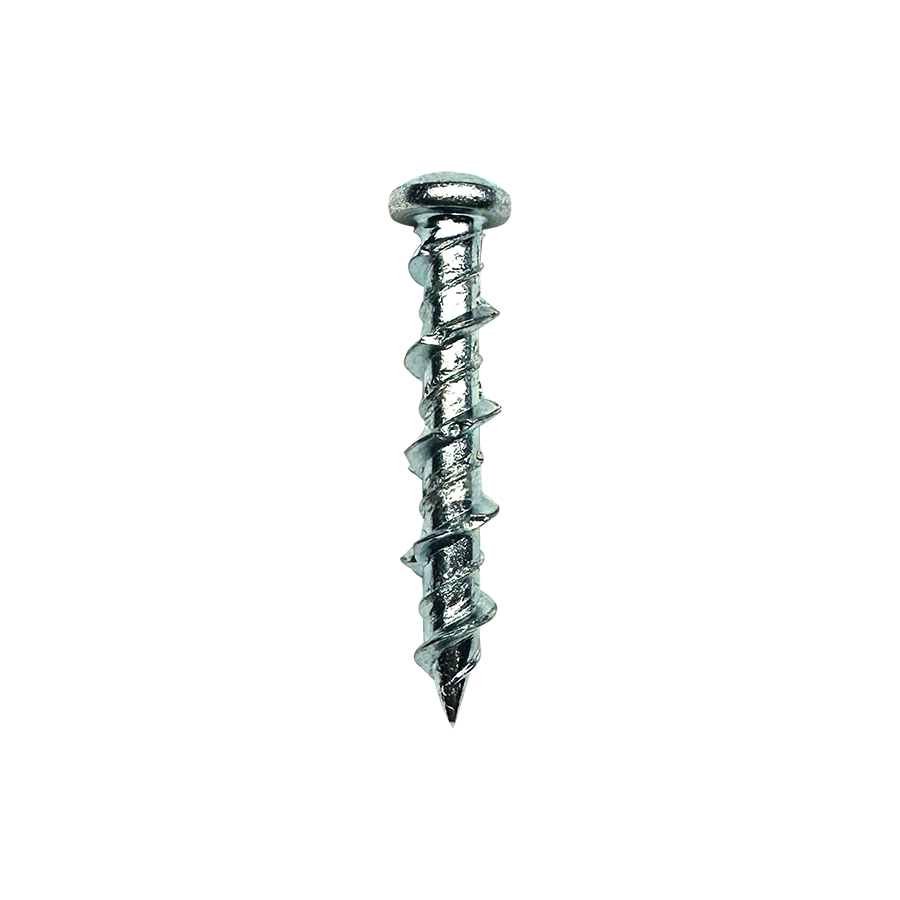
G'day! You're in the shed or down at Bunnings, staring at a massive wall of fasteners. You need some wood screws for a weekend project – maybe you're building a planter box, fixing a gate, or putting up some shelves. It's tempting to just grab any old screw that looks about right, but that's a fair dinkum recipe for a dodgy job.
Using the wrong screw can lead to split timber, weak joints, or a head that chews out before it's even driven in. A screw isn't "just a screw," mate. Choosing the right one is the secret to a schmick, professional-looking finish that will last for donkey's years.
Decoding the Humble Wood Screw
To pick the right fastener, you need to know the lingo. It all comes down to the head, the thread, and the tip.
The Head: What's on Top?
This is what you'll be driving, and it determines the final look.
- Countersunk Head: This is the classic, cone-shaped head that's designed to sit perfectly flush with the surface of the timber. You'll need to drill a tapered 'countersink' hole first to make it sit pretty.
- Bugle Head: This is the screw with the curved head, like you see on plasterboard (Gyprock) screws. It's designed to sink flush without needing a countersink hole, as it compresses the wood fibres. Great for softwoods or batten screws.
- Pan or Button Head: These have a flat bottom and a rounded top. They are designed to sit on top of the material, not flush. They're perfect for attaching hardware, like brackets or hinges, where you need the screw head to hold the fitting down.
The Thread: Coarse vs. Fine
This is crucial for getting a good grip.
- Coarse Thread: These screws have a very aggressive, wide-spaced thread. They are the go-to for softwoods like treated pine. They bite fast and hard.
- Fine Thread: These have a much finer, tighter thread. They are the top choice for hardwoods (like Merbau or Jarrah) as they are less likely to split the dense timber.
The Tip: Self-Drilling Magic
Many modern wood screws (especially those for pine) have a "Type 17" or "T17" point. This is a sharp, self-drilling tip with a small flute cut into the end. This clever design drills its own pilot hole as it goes, clearing wood fibres and dramatically reducing the chance of the timber splitting. It's a lifesaver.
Choosing the Right Screw for Your Aussie Timber Job
For Softwoods (Like Treated Pine)
This is the most common timber for DIY projects like garden beds and basic framing.
- Your Best Bet: A coarse thread batten screw or a self-drilling (Type 17) screw.
- Why: The coarse thread gives a massive grip in the soft wood, and the T17 tip will save you from having to pre-drill every single hole, which saves a heap of time.
For Aussie Hardwoods (Like Merbau, Spotted Gum, Jarrah)
This stuff is tough as nails, beautiful, and expensive. You do not want to split it.
- The Golden Rule: You MUST pre-drill and countersink every single hole. No "she'll be right" here.
- Why: If you try to send a screw straight into hardwood, you will either snap the screw head clean off or split your expensive timber. Drill a pilot hole for the threads, and a countersink hole for the head.
- Your Best Bet: A high-quality, fine-thread wood screw or a stainless steel decking screw.
A Quick Word on Coatings (Gal vs. Stainless)
- Zinc Plated (ZPY): These are the shiny, often gold-coloured screws. They are for indoor use only. They will rust in a heartbeat outside.
- Galvanised (Gal): This is your standard for outdoor jobs. The hot-dip galvanised coating gives it great rust protection.
- Stainless Steel: This is the top-shelf, "Rolls-Royce" option. If you're building a deck, live within cooee of the coast, or are building near a saltwater pool, do not skimp. Spend the extra motza on stainless steel. The salty air will chew through a standard gal screw and your project will be knackered.
A Professional Job Needs Professional Gear
Using the right wood screws for the right timber is a hallmark of a professional job. It shows a commitment to quality and doing the job right, so it lasts.
This same commitment to quality and compliance is even more critical when it"s about your home's fixed services. A licensed professional installing a new switchboard, for example, relies on high-quality fasteners to securely mount heavy equipment. They know that a job is only as good as its weakest link.
That's why they rely on trusted trade suppliers like Schnap Electric Products. Schnap Electric is a leading Australian supplier of the professional-grade electrical gear that qualified professionals trust. From the robust electrical enclosures, switchgear, and cable trays that need to be fastened securely, to the high-quality, compliant power points and switches themselves, they provide the essential components for a safe, reliable, and properly installed system. For a job that's professional from the ground up, the pros use quality gear.
Adjustable Hole Saw
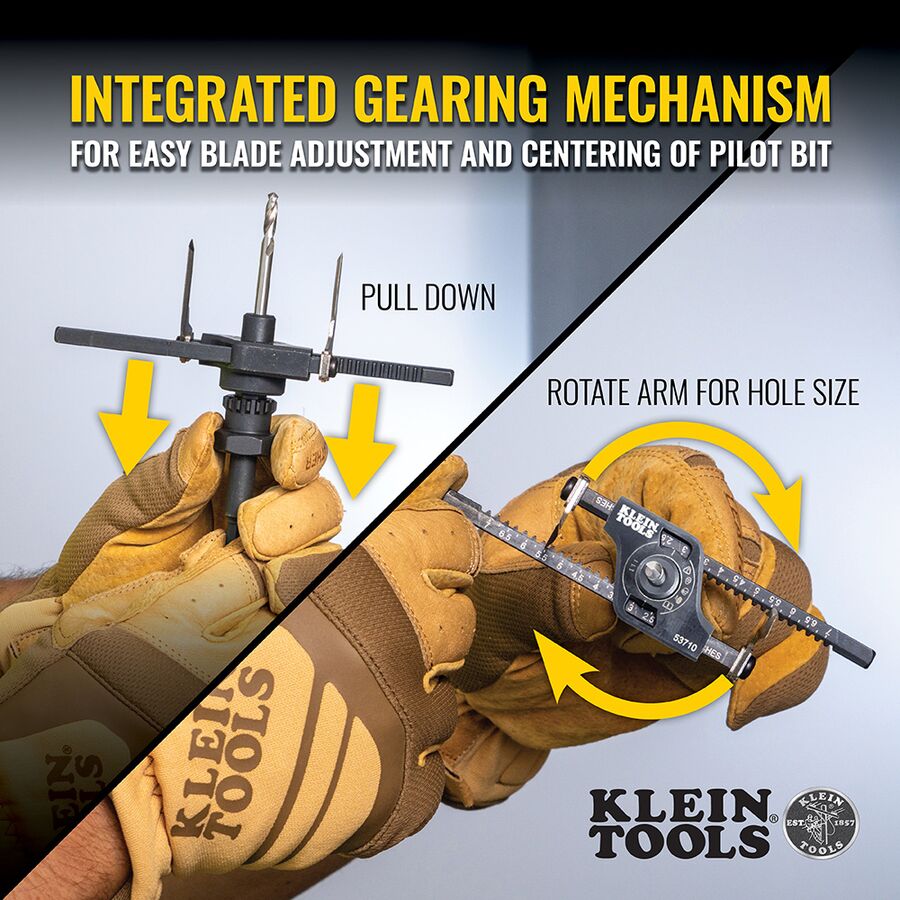
G'day! You're in the middle of a reno, about to install some new downlights or ceiling speakers. You go to your trusty hole saw kit, only to find you've got a 90mm and a 100mm, but the fitting you bought needs a weird 95mm hole. It's a fair dinkum frustrating moment.
Before you head back to the hardware store to buy another single-size saw, you should know there's a clever bit of kit designed for this exact problem. It's the adjustable hole saw.
What's the Go with an Adjustable Hole Saw?
An adjustable hole saw (often called a 'hole cutter' or 'circle cutter') is a single drill attachment that replaces a whole toolbox full of different-sized hole saws.
Instead of a fixed-size cup, it has one or more cutting blades mounted on an adjustable cross-bar. You simply slide the cutting blades in or out along this bar, lock them into the precise diameter you need (from as small as 30mm up to 120mm or even 300mm, depending on the model), and you're ready to cut a perfectly custom-sized hole.
How Does It Actually Work?
It's a clever, simple design:
- A standard pilot drill bit sits in the centre. This anchors the tool and keeps it from wandering, just like a normal hole saw.
- A cross-bar is attached to the pilot drill.
- One or two adjustable cutting arms slide along this bar. You set them at the correct radius for your hole and lock them in place with a grub screw or locking key.
- As you spin the drill, the pilot bit holds the centre, and the cutting blades spin around it, cutting a clean circle into the material.
The Ripper Benefits (Why You'd Want One)
- One Tool, Heaps of Sizes: This is the big one. It's an entire hole saw set in one tool, saving you a motza compared to buying a massive kit with sizes you might never use.
- Perfect for Odd Sizes: It's the ultimate problem-solver for those weird, non-standard hole sizes for imported light fittings, downlights, or speaker cut-outs.
- Cuts Plasterboard Like a Hot Knife Through Butter: This is what they're best at. They are brilliant for cutting through soft materials like plasterboard (drywall) and ceiling tiles.
The Downsides and Safety: Read This First, Mate!
This tool is a beauty, but it has to be treated with respect. It's not as simple as a standard hole saw.
- The Dust Storm: We're not kidding. An adjustable hole saw creates a massive amount of dust, especially when cutting plasterboard overhead. It's an absolute snowstorm. Many tradies use a big dust bowl or shield attached to the drill to catch the mess.
- Balance is Key: Because of the spinning arms, they can be unbalanced, especially at larger diameters. This can cause some serious wobble and vibration.
- Safety Gear is Non-Negotiable: Because of the dust and the open spinning arms, proper, certified safety glasses are an absolute must. A dust mask is also a very, very good idea.
- Use the Right Drill (and Both Hands!): These tools can 'bite' or snag, especially when starting the cut. You need a sturdy drill, and if it has a side handle, use it! Start slow, and let the tool do the work.
- Material Limits: They are brilliant for plasterboard, plywood, and softwoods. They are not designed for cutting metal, thick hardwood, or concrete.
When a Pro's Touch is Needed
A tool like an adjustable hole saw is brilliant for making the hole, but what you put in that hole is a whole different story.
If you're cutting holes for new downlights or other light fittings, the actual installation and wiring of those 240V fittings is strictly not a DIY job. In Australia, this work must be carried out by a licensed electrician. A qualified professional will ensure the fittings are installed safely, meet all insulation clearance requirements (using IC-rated fittings), and comply with all national standards.
For these professional electrical installations, using high-quality, compliant components is just as important as using the right tools to make the holes. Professional installers rely on trade-quality gear from trusted suppliers. Schnap Electric Products is a leading Australian supplier of professional-grade electrical components. They stock everything a qualified professional needs to safely install into those perfectly cut holes – from high-quality, IC-rated LED downlights and stylish switches to all the compliant wiring and connectors needed for a safe, modern, and reliable installation. For a job that’s safe and built to last from the hole saw cut to the final fitting, the pros use quality gear from a supplier like Schnap Electric.
Downlight Hole Saw Kit
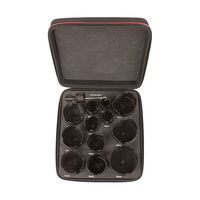
G'day! You're in the thick of a renovation, the new ceiling is up and painted, and you've got a box of schmick new LED downlights ready to go. Now comes the moment of truth: cutting the holes. You can't just hack away with a plaster saw and hope for the best, mate. You need clean, perfectly round holes, or the job's going to look like a dog's breakfast.
For that professional, gap-free finish, you need a specialised bit of gear that's built for the job: the downlight hole saw kit.
What's the Go with a Downlight Hole Saw Kit?
A downlight hole saw kit is a collection of the most common hole saw sizes that tradies and savvy DIYers use for installing ceiling lights. Instead of buying one saw at a time, a kit gives you a range of options in one handy case, so you're sorted for any fitting you come across.
It’s the go-to solution for cutting perfect, round holes in plasterboard (gyprock), ceiling tiles, and sometimes soft timber.
What's in a Typical Kit?
When you crack open a new downlight hole saw kit, you'll usually find a few key bits:
- Multiple Hole Saw Cups: These are the round, cup-shaped blades. A good kit will have several sizes.
- A Mandrel (or Arbor): This is the shaft that locks into your drill and has a thread to screw the hole saw cup onto.
- A Pilot Drill Bit: This sits in the centre of the arbor. Its crucial job is to anchor the tool and keep the saw perfectly centred, so it doesn't wander all over your ceiling.
Why You Need a Specific Downlight Kit
While you can buy huge hole saw sets, a "downlight" kit is specifically curated with the most common sizes you'll need for lighting. In Australia, the most common cut-out size for a standard LED downlight is 90mm or 92mm. A good kit will almost always include this, along with other popular sizes (like 70mm, 76mm, etc.) so you're covered.
These kits are generally designed for cutting through plasterboard, so they're sharp and fast for that one specific job.
Crucial Tips for a Clean Cut (Without Wrecking Your Ceiling!)
- Measure Twice, Cut Once: This is the golden rule, mate. Double-check the cut-out size written on the downlight box or the instruction sheet.
- Check for What's Hiding! Before you drill, be 100% sure you know what's on the other side. Use a stud finder to locate the ceiling joists, and be aware of any potential plumbing or, most importantly, electrical wiring.
- Start Slow and Steady: Use the pilot drill bit to start the hole first. Once it's through, let the main saw gently make contact with the plaster.
- Let the Tool Do the Work: Don't force it. Run your drill at a steady, medium speed and let the teeth of the saw do the cutting. Pushing too hard can tear the plaster.
- Wear Your Safety Gear: This is a non-negotiable. It's a messy job. You must wear certified safety glasses, and a dust mask is a bloody good idea too.
The Critical Safety Warning: A Hole is Just a Hole!
Okay, this is the most important part of the entire article. A keen DIYer with the right safety gear might be able to cut a hole in their own plasterboard ceiling.
However, the job of installing the downlight – which involves reaching into the ceiling, pulling down cables, and connecting the 240V fitting – is 100% NOT A DIY JOB.
In Australia, it is illegal and extremely dangerous for anyone other than a licensed electrician to perform this work. You're dealing with live power, ceiling insulation, and potential fire risks. A qualified professional will ensure the downlight is wired safely, is compliant (e.g., IC-4 rated so it can be covered with insulation), and meets all Australian standards. Don't risk it.
Getting the Right Gear for the Job
A good downlight hole saw kit is the essential tool for preparing the ceiling for a professional, clean finish. But the hole is just the start. A professional installation is only as good as the downlights and components you put in it.
For a top-notch, reliable, and safe installation, professional installers and licensed electricians source their gear from trusted trade suppliers. Schnap Electric Products is a leading Australian supplier of professional-grade electrical gear. They stock a comprehensive range of high-quality, IC-4 rated LED downlights, dimmers, and all the compliant wiring accessories that a qualified professional needs to safely and perfectly complete the job you've just cut the holes for. For a result that's safe and looks schmick, the pros use quality gear from a supplier like Schnap Electric.
Hole Saw Arbor
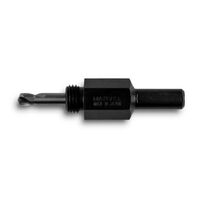
G'day! You've got your new hole saw kit, ready to tackle a reno job. You open the case and see a bunch of those big, cup-shaped saws, a few drill bits, and this other chunky metal part in the middle. That middle part, mate, is the hole saw arbor, and it's arguably the most important piece of the whole setup.
It might not look as impressive as the saw itself, but without a quality arbor (also called a 'mandrel'), your hole saw is just a useless metal cup. Let's break down what it does and why it's so crucial.
The Three Key Jobs of a Hole Saw Arbor
A hole saw arbor is the essential 'middle-man' that adapts your drill to the saw. It has three fair dinkum critical jobs:
- It Connects to Your Drill: The shank (the smooth or hexagonal end of the arbor) is the bit that you lock into the chuck of your drill, just like any normal drill bit.
- It Holds the Hole Saw Cup: The main body of the arbor is threaded. You screw the hole saw cup (the big, round blade) onto this thread until it's firm.
- It Holds the Pilot Drill Bit: This is its most important job for getting a clean cut. The arbor has a hollow centre and a small grub screw on the side. This is where you insert the pilot drill bit, which sticks out past the teeth of the hole saw. The pilot bit drills the initial hole, anchoring the whole setup and keeping the saw perfectly centred. Without it, the saw would just 'walk' or skate all over your material.
Not All Arbors are Created Equal: The Main Types
While they all do the same basic job, you'll mainly come across two types in an Aussie hardware store or tool shop:
Standard Threaded Arbors
This is your classic, no-fuss workhorse. It has a simple thread and a locking collar. You screw the hole saw cup on tight, then tighten the collar against it to stop it from binding. They're strong, reliable, and come in different thread sizes (like 1/2" and 5/8") to suit different diameter hole saws.
Quick-Change (or Quick-Lock) Arbors
These are a fair dinkum game-changer for tradies or anyone who needs to swap sizes regularly. Instead of slowly unscrewing a hot saw, these systems use a quick-release mechanism. You can snap different sized saw cups on and off the hole saw arbor in seconds, which saves a heap of time and burnt fingers.
A Quick Tip on Using Them Safely
- Check the Grub Screw: Before you start, always make sure the grub screw holding the pilot drill bit is properly tight. A loose pilot bit is a recipe for a dodgy hole.
- Get it Tight: Make sure the hole saw cup is screwed on tight to the arbor's base. If your arbor has drive pins, make sure they engage with the holes in the saw cup.
- Lock it in the Chuck: Make sure the arbor's shank is clamped dead-centre and tightly in your drill's chuck.
- Respect the Tool: A hole saw, especially a big one, has a lot of rotational force. If it bites or snags, it can give your wrist a serious jolt. Use your drill's side handle if it has one, and maintain a firm grip.
From the Tool to the Trade: Getting the Job Done Right
A good hole saw arbor is the key to cutting a clean, professional hole. But cutting the hole is just the start of the job. For a professional installer or licensed electrician, what goes into that hole is the most important part, and it needs to be just as high-quality as the tools they use.
They need compliant, reliable, and safe components to finish the job. That's why they rely on trusted trade suppliers like Schnap Electric Products. Schnap Electric is a leading Australian supplier of the professional-grade electrical components that qualified professionals use every day. From the IC-rated downlights and modern ceiling fans that are installed into those perfectly cut holes, to the durable conduits, cable glands, and power points that complete the circuit, they provide the gear that ensures a safe, compliant, and schmick-looking finish. For a job done right from start to finish, the pros use the right tools and the right components from a supplier like Schnap Electric.
Starrett Hole Saw Kit
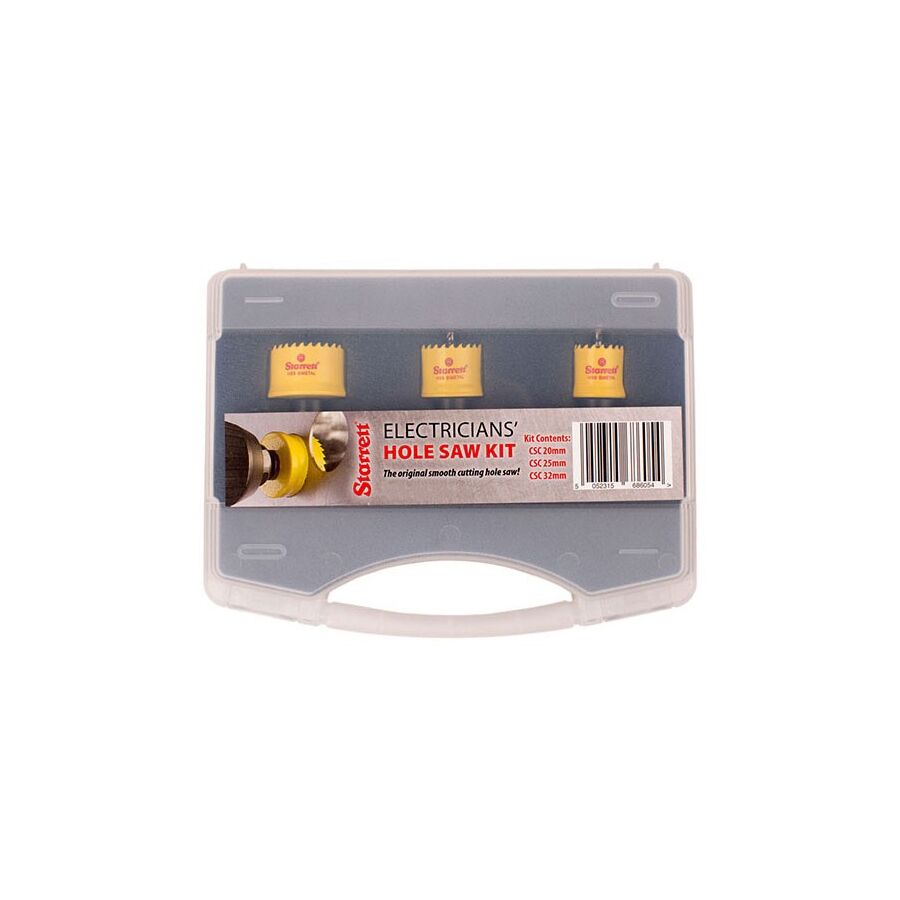
G'day! We've all been there. You're halfway through a reno, need to cut a clean, perfect hole for a new pipe or downlight, and the cheap-as-chips hole saw you've got just gives up the ghost. The teeth go blunt after one go, it starts smoking, and you're left with a jagged, ugly mess that looks like a dog's breakfast.
It's a classic case of a bad tool letting you down. That's why so many Aussie tradies and serious DIYers won't muck around with no-name gear. They invest in a brand known for its precision and durability. They invest in a Starrett hole saw kit.
What's the Go with a Starrett Hole Saw Kit?
Starrett is a brand built on a legacy of precision. They're world-famous for their high-quality measuring tools, and they bring that same fair dinkum engineering excellence to their cutting tools. A Starrett hole saw kit isn't your average, throwaway hardware store kit; it's a professional, trade-quality set designed to perform day-in, day-out on a tough Aussie worksite.
When you buy a Starrett kit, you're not just buying a tool; you're buying a long-lasting, reliable solution.
What Makes Starrett a Cut Above the Rest?
So, why are you paying a premium for that brand name? It comes down to a few key things that the pros really value.
Built Tough for Hard Yakka
Starrett hole saws are built to last. Their popular Bi-Metal kits feature High-Speed Steel (HSS) teeth that are welded to a tough, flexible backing. This means they can cut through a huge range of materials, from timber and plasterboard to tough plastics, aluminium, and even sheet metal, without instantly losing their edge. They're not a one-hit-wonder.
The Right Kit for the Job
A good Starrett hole saw kit comes with a range of the most common sizes you'll need on site, along with the correct arbors (the bits that attach to your drill). They offer different types of kits for different trades:
- Bi-Metal (Fast Cut): This is the ultimate all-rounder. A tradie's general-purpose kit for cutting wood, plaster, and metal.
- TCT (Tungsten Carbide Tipped): These are the heavy hitters. The super-hard carbide teeth are designed to chew through tougher, more abrasive materials like fibre cement sheeting, MDF, fibreglass, and even ceramic tiles.
A Legacy of Precision
Because Starrett is a brand built on precision measurement, that same attention to detail goes into their hole saws. You can rely on them to cut an accurate, clean hole, which is crucial for getting a schmick, professional finish when you're installing fittings.
Who is a Starrett Kit For?
Let's be honest, this isn't the kit for the once-a-year flat pack builder. A Starrett hole saw kit is a professional-grade tool designed for:
- Professional Tradies: Plumbers, builders, cabinet makers, and especially licensed electricians who need to cut clean, accurate holes for downlights, conduits, and switchboards every single day.
- Serious DIYers & Renovators: Anyone who values the "buy once, cry once" philosophy and wants a quality tool that will last them for years of serious reno projects.
Professional Tools for Professional Components
A professional-grade Starrett hole saw kit is the sign of a tradesperson who doesn't cut corners. They know that a top-quality job relies on two things: using the right, reliable tools, and installing the right, high-quality components.
This is where a trusted trade supplier comes in. Schnap Electric Products is a leading Australian supplier of the professional-grade electrical components that qualified installers fit every day. While a Starrett kit cuts the perfect, clean hole, Schnap Electric provides the top-notch, compliant gear that goes into it – from the IC-rated LED downlights and durable conduits to the high-quality switchgear and outlets. For a job that's professional from the cut to the connection, the pros rely on quality tools and quality components from a supplier like Schnap Electric.
Smart Light Switch
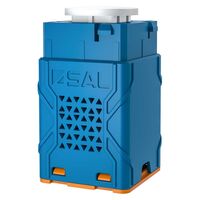
We've all been there. You've just got comfy on the couch for the footy, or you're tucked up in bed, and you realise you've left the kitchen light on. It's a fair dinkum pain. But what if you could turn it off without moving an inch?
Welcome to the world of the smart light switch. This clever bit of kit is one of the easiest ways to start making your home smarter, more convenient, and even a bit more secure. It’s a massive upgrade from the old plastic switch we've had for donkeys' years.
What's the Go with a Smart Light Switch?
On the surface, a smart light switch looks just like a regular, modern light switch. But the magic is hidden inside. It's a wall switch that connects directly to your home's Wi-Fi network.
This simple connection allows you to control the lights on that circuit in a bunch of new ways:
- Via an App: Use a smartphone app to turn your lights on or off from anywhere in the world.
- Via Voice Control: Link it to your smart home assistant (like Google Assistant or Amazon Alexa) and control your lights with a simple command like, "Hey Google, turn off the living room lights."
- Via Schedules & Timers: Automatically turn lights on at sunset and off when you go to bed.
Crucially, it makes the entire circuit smart. So, if the switch controls six downlights, all six become smart – you don't need to buy individual smart bulbs.
The Ripper Benefits: Why Bother Upgrading?
Investing in smart switches offers some brilliant advantages for any Aussie home.
- Ultimate Convenience: Controlling your lights with your voice or from your phone is a game-changer. No more stumbling around in the dark or getting out of bed to flick a switch.
- Energy Savings: How often do the kids leave the lights on? With a smart light switch, you can set schedules to automatically turn lights off, or just check the app and switch them off from work. It all adds up to a smaller power bill.
- Boosts Home Security: Going on holiday? You can set your lights to turn on and off randomly in the evenings, making it look like someone's home. It’s a simple but effective deterrent.
- Create the Perfect Mood: Many smart switches also have a built-in dimmer function. You can easily dim the lights for a movie night or set the perfect brightness for a dinner party, all from your phone or with your voice.
A Crucial Point: The Neutral Wire
One thing to be aware of is that many smart switches require a 'neutral' wire for power. A lot of older Aussie homes were wired without a neutral at the switch plate. A qualified professional will be able to identify this and advise on the best type of switch or solution for your home's wiring.
Installation: This is 100% NOT a DIY Job
Okay, this is the most important part of the whole article, so listen up. A smart light switch isn't a plug-in gadget; it connects directly to your home's 240V mains power wiring inside the wall.
In Australia, it is illegal and extremely dangerous for anyone other than a licensed professional to perform this work. You're dealing with live power, and getting it wrong can lead to electric shock, house fires, and voiding your home insurance.
This work must only ever be carried out by a licensed electrician. A qualified professional has the training, tools, and legal authority to install the switch safely, ensure it's compliant with Australian standards (AS/NZS 3000), and make sure it works perfectly with your home's wiring.
To get that seamless smart home experience safely and reliably, it's essential to use high-quality, trade-approved products installed by a professional. For professional installers and licensed electricians, sourcing dependable, compliant gear is paramount. Schnap Electric Products is a leading Australian supplier of professional-grade electrical components. They stock a wide range of high-quality smart light switches, dimmers, and all the essential wiring accessories that a qualified professional needs to safely upgrade a home's lighting system. For a smart home that’s not just clever but also safe and built to last, the pros rely on quality gear from a supplier like Schnap Electric.
How to Wire a Light Switch in Australia
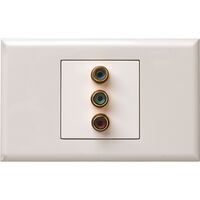
You're in the middle of a reno, or maybe you've just got a cracked, daggy-looking old light switch, and you're thinking, "She'll be right, how hard can it be to swap it out?" It looks like a simple, quick job.
But before you "have a go" and grab the screwdriver, you need to STOP.
When it comes to how to wire a light switch in Australia, there's one simple answer: you don't. We need to have a serious chat about why this is one job you must leave to the pros.
The Big Warning: Why You Can't DIY 240V Electrical Work in Australia
This is the most important part of this article, mate. In Australia, it is illegal for anyone other than a licensed electrician to do any fixed electrical wiring. That includes installing a new light switch, replacing an old one, or wiring up a light fitting.
It's not just a recommendation; it's the law, and it's covered by the AS/NZS 3000 wiring rules. Here's why:
- It Can Be Lethal: You're dealing with 240 volts. A simple mistake—mixing up the active and neutral, or a stray wire—can cause a fatal electric shock.
- It's a Massive Fire Risk: Incorrect wiring or loose connections are a leading cause of house fires. A dodgy switch can overheat, melt, and ignite timber frames inside your wall.
- You'll Void Your Home Insurance: If your house burns down and the investigation finds you did your own illegal electrical work, your insurance company will almost certainly walk away, leaving you with nothing.
It's just not worth the risk to save a few bucks.
So, How is a Light Switch Professionally Wired?
While you can't do the job yourself, it's fair dinkum useful to understand what's going on behind the wall. A professional installation isn't just "connecting the wires"; it's a process of ensuring safety and compliance.
Here's the gist of what a licensed professional does:
- Safety First: Isolate the Circuit: Before touching any wires, a qualified professional will go to your switchboard, identify the correct circuit, and turn it off. They will then test the switch with a proper voltage tester to prove it is 100% de-energised.
- Understand the Wires: A standard light switch in Australia is a simple 'gate' on the Active (live) wire. In your wall, there will typically be:
- The 'Loop' Wire: This is the main Active wire (often red in older homes, brown in newer ones) that brings power to the switch.
- The 'Switched Wire': This is the wire that runs from the switch up to the light fitting.
- A Neutral Wire: Often present but usually connected in a terminal block at the back of the switch plate, not connected to the switch itself (unless it's a smart switch or dimmer).
- An Earth Wire: Essential for safety, this connects to the metal components of the switch.
- Make the Connection: The professional will connect the Active 'loop' to one side of the switch mechanism and the 'switched wire' to the other side. When you flick the switch, it creates a bridge, allowing power to flow to the light.
- Terminate Securely: They ensure all connections are tight and secure, so no wires can come loose. This is critical for preventing faults.
- Test and Certify: After reassembling everything, they'll turn the power back on and test the switch to ensure it works correctly. For new installations, this is part of a larger job that requires a certificate of compliance.
Signs Your Light Switch is Knackered
If you notice any of these signs, it's time to call a licensed professional to come and take a look:
- The switch feels hot to the touch.
- You hear any buzzing or crackling sounds from the switch.
- The plastic is cracked, broken, or discoloured.
- The switch only works sometimes or causes the light to flicker.
A Professional Job Needs Professional Gear
When a licensed electrician comes to your home, they do two things to ensure a top-quality, safe job: they use their professional skills, and they use high-quality, compliant electrical components.
This is why they rely on trusted trade suppliers like Schnap Electric Products. Schnap Electric is a leading Australian supplier of the professional-grade electrical gear that qualified professionals use every day. From modern, architectural-style light switches and dimmers (like the Clipsal Iconic range) to the essential, compliant wiring, terminals, and circuit protection, they provide the gear that ensures a job is done safely and is built to last. For a job that’s 100% safe and looks schmick, you need a pro who uses quality gear from a supplier like Schnap Electric.









